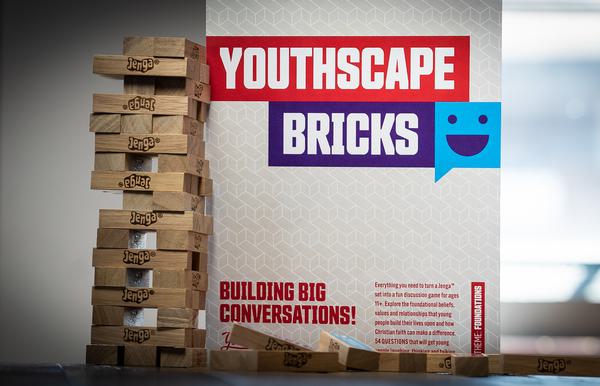Struggling with a dwindling youth work team? Here’s seven tips for pitching the joy of volunteering to your church.
Some recruitment tasks are easy. Like if, say, someone offered you a hundred thousand pounds a year to come and be the youth minister at their church. In Hawaii. Or imagine you suddenly had a couple of spare Beyoncé tickets – you'd expect that opportunity would be snapped up fairly quickly, possibly with some scuffling between competing friends. These lie at one extreme end of the recruitment spectrum.
At the other – at least – as we youth leaders perceive it, is the 'ask' to become a youth volunteer. Standing at the front of a morning service as babies and 'spirited' children try to drown you out; sandwiched in between notices about Alpha and financial giving; most of us deliver this pitch with utter confidence that our impassioned and visionary call for help will produce zero results. Plus, we know everyone is going to be avoiding eye contact with us during the post-service tea and coffee.
This task has always been famously tricky, but Covid has just turned up the difficulty level from Intermediate to World Class. Not only are many youth groups seeing volunteers step down (often for very good reasons), but there seems to be an increased reticence to take anything on. After the lockdown experience taught people to slow down and do less, it seems like service and volunteering have fallen lower down the priority list. Put simply, it now feels like the exact polar opposite of standing up there and asking: "who wants free hotdogs?"
After two decades in youth work, I've made that ask many times. Sometimes it's gone horribly – I remember in a previous church being cut off by the minister who co-opted it as a recruitment drive for something else entirely – and sometimes it's simply provoked a week of eerie silence where I've wondered if I've been secretly excommunicated from the church family. On occasion however, I've seen these asks for help connect with brilliant people who have since gone on to be some of our most dedicated and trusted volunteers. The seven points below (because frankly, who doesn't love bullet points, and seven is the perfect number) are the distilled learnings of the times that the pitch worked. None of them are foolproof, and none involve bribing people with free Beyoncé tickets, but hopefully they'll inspire and encourage you to give the dreaded call for help one more try...
1. Timing is everything
Try to agree a good time to make your presentation to the church. 'Giving Sunday' is a terrible week to do it, because everyone is already on edge; so are other services which have another key focus or contain a hundred other important notices. Think through your context, and try to find a time when you'll have the best amount of concentration from the maximum number of people. Although it's counter-intuitive, this might be after children and their leaders have already gone out to groups (if you have them).
2. Lead with vision, not desperation
People are much more likely to respond to a call to action that is visionary, rather than a cry for help. It may be true that the pandemic has left your team decimated to the point that you can no longer run activities, but who wants to step on to a sinking ship? Tell people what your hopes are; what you believe your church and/or group can do to connect young people with the awesome and transformational love of God. Give your audience a picture of what could be with their help – not a worrying image of a dwindling dream.
3. Make it memorable
Try to find a way to ensure that what you say stands out in the service. This may involve a bit of media, an interesting prop, a bit of call-and-response, or perhaps something a bit more meaningful like an interview with a young person. Your mission is to help people recall what you've said after the flurried exit from church has cleared their working memory. Giving them something to take away – such as a prayer bookmark for the youth ministry – is one possible way of prompting their thoughts after the service is over.
4. No discounts!
One of the chief reasons why people don't volunteer is that they mistakenly believe that the opportunity does not apply to them. When they hear phrases like 'youth work' or 'working with young people', they perhaps immediately picture a kind of cool Peter Pan figure who spends their free time creating TikToks and using words like 'dope', 'peng' and 'lit'*. They also imagine a series of limits around age, stage of life, and knowledge of understanding of youth cultures. Your job is to disarm this, and the best way to do so is by naming it. Anyone (as long as they're safe) can be a youth worker – and in fact some of the least suitable youth leaders are the very people who attempt to be 'down with the kids.' Reassure that you want people to just be themselves – and to listen to and care for young people.
*Young people don't actually talk like this.

5. Give options
Not all volunteering needs are alike, and creating a small range of options may draw in those who had otherwise counted themselves out. If you run multiple groups, at different times of the week, make sure that you explain this as it may open up people's availability. Similarly, if you have needs such as food preparation, driving, setup and clear-up and prayer, make sure these are advertised too. I know quite a few people – often they're teachers – who don't really want to spend more of their time with teenagers, but are happy to help in a range of other ways. So, make sure your message is clear: it takes a village to raise a child, but not all of the villagers have to hang out with the kid.
6. On probation
It's always smart to time-limit a volunteer's initial place on your team, and this works two ways. From the volunteer's perspective, it means that they are not immediately signing their Friday nights away to a role that they might possibly hate. From your perspective as the leader, it's a chance to make sure that they're a good fit. The subsequent conversation when it doesn't work out on either side is a lot less awkward when you've agreed to have it in advance. I've found that people are much happier to agree to a trial period of volunteering – and when the fit is good, they'll almost certainly be happy to make a longer-term commitment.
7. Be specific with your ask
Finally, whatever you do, don't pull your punch! Make sure that everyone listening is left with a crystal-clear idea of what you want from them, and how they can respond. An altar-call probably won't work, but a named person that they could talk to at the end of the service possibly will. Make sure that people also have a deadline for expressing interest; again this might seem like it could put people off, but vague requests about helping at some point in the future don't feel urgent or important enough to respond to.
There are of course a range of other ways to issue a call to volunteers – including emailing and writing to people, and approaching individuals face-to-face. Still, there's no better place than a church service to find yourself a captive audience of exactly the sorts of people who could staff your newly-rebuilt volunteer team. Though it's a challenging task, we urge you to follow some of the steps above, and go again.











